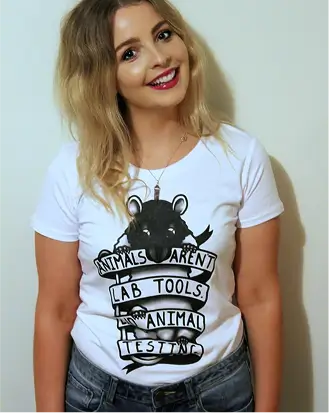Frequently Asked Questions
Ending animal experimentation would benefit not only the animals but us as individuals and as a society. Ending animal experimentation and the harmful use of animals in science helps…
... Animals
Every year, several thousand animals are enduring extreme pain or discomfort during experiments in Aotearoa. Some animals, particularly rats and mice are bred in excess, just to be killed when they are not needed. A lot of research is conducted for the animal agriculture industry so that animals can be more ‘efficiently’ exploited.
... People
Animal experiments regularly fail to detect if a drug or medicine is going to be toxic to humans. We know of many drugs that would have been abandoned before ever reaching human patients if they had been tested on the “wrong” species. Additionally, researchers conducting animal experiments often struggle with their conscience. Alternative methods of teaching anatomy and physiology are teaching students better and more ethically than animal dissections.
... Science
Keeping, breeding, and testing on animals is incredibly expensive and takes a long time, funnelling resources away from more meaningful work. Animal-free research methods like Organ-on-a-chip enable researchers to observe and measure things that are simply impossible to access using animals. Animal-free methods are often not only cheaper but more accurate.
Our small team has achcieved a lot of big wins over the years, thanks to the help of our wonderful supporters! Most notably NZAVS has;
- Colabortated with the animal science and research industry to urge them to replace their harmful use of animals. This lead to Massey University to publish a Statement of Intent to publicly show it is ‘committed to replacing the use of animals for science, wherever possible, as technology permits.’
- Following our Out of the Labs campaign we have rehomed hundreds of animals used or bred for science in Aotearoa.
- Our Forced Swim Test campiagn effectivly ended the use of this cruel and invalid test in NZ.
- Delivered a petition with more than 22,000 signatures to parliament to ask the government to make better decisions for animals in RTT.
- Joined forces with Humane Society International and HUHA to ban the testing of cosmetics on animals in NZ.
- Secured a government ban on testing psychoactive substances on animals.
- Successfully lobbied decision-makers resulting in the explicit requirement for the Draize Test to be removed from NZ law.
- Gifted our kids book about animal testing to all schools in Aotearoa.
- Rallied our supporters to stop the use of live sheep in a training workshop.
Read more about these supporter fueled victories here!
Vivisection is the practice of cutting into or using invasive techniques on live animals. It is commonly called animal experimentation.
What is animal experimentation?
Animal experimentation is the use of animals for claimed scientific purposes where animals are forced to undergo procedures that are likely to cause them pain, injury or death, and that is not meant to benefit the individual animal involved.
Animal experimentation is often detrimental to the individual animals involved and can include:
- Forcing animals to inhale toxic substances
- Force-feeding or injecting animals with potentially lethal substances
- Subjecting animals to situations whereby they are deprived of their basic needs (food, water, shelter, sunlight, air, companionship)
- Putting animals in terrifying situations to create depression and anxiety
- Creating illness, disease or injury deliberately by subjecting healthy animals to invasive medical procedures such as removing organs or tissues.
- Killing animals to use their bodies in dissections.
- Purposefully breeding animals to create offspring that are more susceptible to disease, pain or distress during their life.
At NZAVS, we work tirelessly to end animal experimentation in Aotearoa, New Zealand by:
- Advocating - for the use and funding of scientifically viable and ethical, animal-free research, testing and teaching methods.
- Lobbying—for policy and legal changes, as well as changes to the systems that use animals for research, testing, and teaching methods.
- Collaborating - with as many decision-makers and key stakeholders as we can, at all levels, to influence and create positive long-term change for animals used in research, testing and teaching.
- Educating - to help change cultural, societal, and organisational behaviour and attitudes towards using animals in research, testing and teaching.
You will see that the team at NZAVS will sometimes use the term "animal testing" and at other times "animal experimentation". Though these terms both relate to vivisection, there is important differences between the two.
Animal Testing
This refers to the use of animals to test products, or hazardous substances. Cosmetics, chemicals or medicines are often tested on animals as a flawed attempt to test their efficacy or safety.
Animal Experimentation
When we talk about animal experimentation we refer to the wider use of animals outside of product testing. Examples include:
- Using animals in an attempt to mimic human diseases
- Develop new treatments
- Study how much an animal can grow on a particular diet.
Experimentation also includes research into basic biological functions like breathing, reflexes, pain or hormones, as well as the study of various aspects of animals like their cognition, reasoning abilities or place in the ecosystem (including the best ways to get rid of some).
There are unfortunatly many barriers preventing the progress of animal free methods.
- Outdated laws and regulations: Laws still require animal testing, blocking non-animal methods from being used.
- Lack of funding: No dedicated funding for non-animal methods means no incentive for progress.
- Lack of transparency: Harmful research that would cause outrage happens behind closed doors, hidden from the public eye.
- Risk-averse decision making: Decision-makers are hesitant to step away from the status quo and embrace animal-free and human-relevant science.
- Financial interests: The animal experimentation industry is a global multi-billion-dollar industry, meaning many stakeholders benefit from the existence of animal experimentation.
- Public misconceptions: Many people still believe animal testing is necessary to save lives, but human-focused, animal-free methods are outperforming outdated animal models.
- The ease of animal-based research: It is easier to apply for and plan animal-based research than to organise trials with humans, and ethics approval for animal experiments is rather easy to get.
- Publish-or-perish: Research relying on animals is prioritised and sometimes required by journals, reviewers and funders, pressuring researchers to use animal methods if they want to advance their careers.
- Developing animal-free methods isn’t a priority: Lack of incentives, funding, and strategy leaves the use and development of animal free methods sidelined.
The use of animals in cosmetic testing was banned in Aotearoa in 2025, but unfortunately there are many other ways animals are experimented on here.
Organisations who use animals are required to provide information to MPI on the purpose of their manpiulations. These purposes fit into the following broad catergories;
- Basic biological research: Research that aims to understand the workings of living things.
- Veterinary research: Research aimed at improving the health and welfare of production andcompanion animals.
- Teaching: Animals used for teaching or instruction, at any level.
- Animal husbandry research: Animal husbandry, including reproduction, nutrition, growth and production.
- Medical research: Research aimed at improving the health and welfare of humans, but not research on human subjects.
- Testing: Animals used for public health testing or to ensure the safety, efficacy orquality of products, in order to meet the regulatory requirements for human or animal products, either in New Zealand or internationally.
- Environmental management research: Environmental management, including the control of animal pests and research into methods of reducing production of greenhouse gases.
- Species conservation: Work directed towards species conservation. The species to be conserved may or may not be directly involved (for example some studies may involve using a smaller animal than the endagered one as they are cheaper to use).
- Production of biological agents: Animals used for raising antibodies or for the supply of blood products.
- Development of alternatives: Work aimed at developing methods to replace or reduce the use of live animals in research, testing and teaching.
- Producing offspring with compromised welfare: Breeding animals, using a breeding technique that produces offspring that maybe/are likely to be more susceptible or at greater risk of pain or distress during their life.
- Other: Manipulations for purposes other than those listed above.
For more information on how differenent animals are used in NZ, see our case studies page here.
The numbers fluctuate, but around 300,000 animals are used for research, testing and teaching every year in Aotearoa.
The Ministry for Primary Industries (MPI) gathers statistics on not only how many animals were used, but also;
- how many were killed after use
- how many were bred and killed without being used
- what kind of study they were used for
- where they were sourced from
- where they were used.
You can see a breakdown of each years numbers on our Statistics page here.
Simple ways you can help animals today:
- Subscribe to our mailing list and join our calls to action (like signing petitions)
- Reduce your animal consumption - there is a big connection between animal experimentation and animal consumption
- Educate your friends and family on animal replacement alternatives (add link to BFR)
- Use our resources about animal-free education in schools (link to resources)
- Lobby your local MP/government for change
- Buy cruelty-free
- Opt out of dissections at your school/university (link to resources)
- Don't donate money to organisations that support or conduct animal experiments
Ways to support NZAVS:
- Donate to NZAVS via our website
- Donate and vote on My Giving Circle- the platform that provides chairties with grants!
- Buy our merchandise
- Fundraise through Raisley - host a bake sale or do a fun run and donate the proceeds to us!
- Become a member of NZAVS and vote at our Annual General Meetings
- Leave a gift in your will
- Donate via IRD payroll giving





